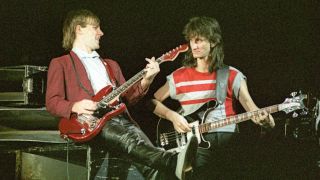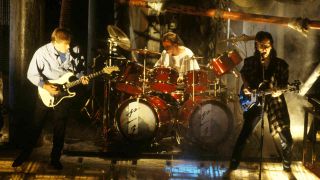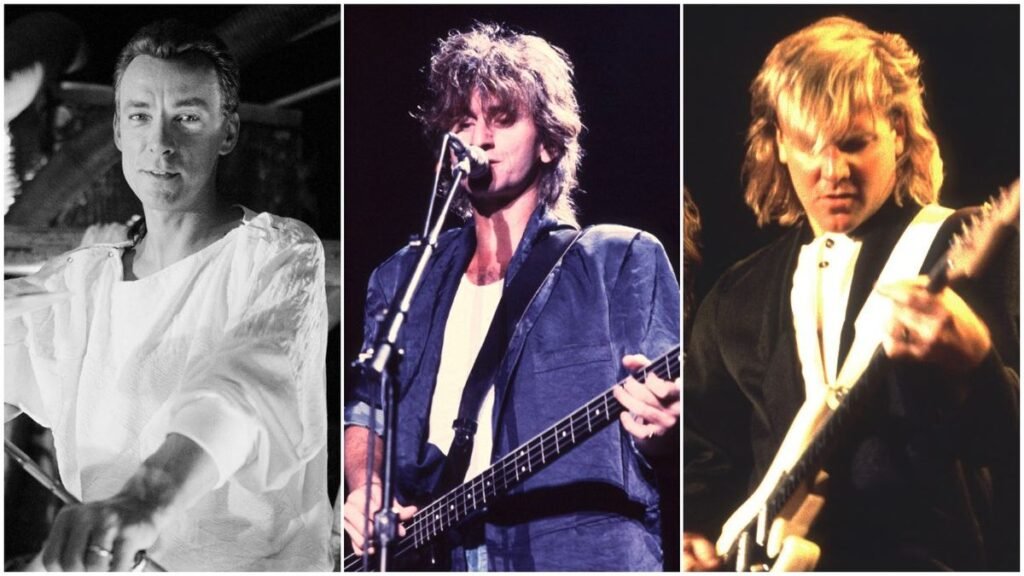Rush’s sound had developed and remodeled over the process the 8 albums they made between their self-titled debut and Transferring Photos. However 1982’s Indicators was once a blank ruin with the previous, pivoting clear of the good guitar epics of the 70s against a state of the art keyboard-oriented sound – to the chagrin of a few in their hardcore fanatics.
No longer that Rush themselves have been involved. Relatively than retreat to acquainted floor, the trio as a substitute opted to double down on their debatable new way and completely embody new sounds and applied sciences. Starting with 1984’s Grace Below Drive, their adventure thru the remainder of the last decade would take them some distance from their roots – one thing now not each band member was once pleased with.
Indicators was once a pivotal album for Rush in lots of respects. In addition to kicking off the 3rd bankruptcy in their profession, it marked the purpose the place they parted corporate with longtime manufacturer and mentor Terry Brown. “We needed to get started proper from the bottom up in making issues as other as lets,” mentioned drummer Neil Peart of the verdict.
To discover a new manufacturer for the follow-up to Indicators, Rush started scouring the credit of albums they appreciated, drawing up a listing of attainable applicants. With studio time booked for November 1983 at Le Studio in Quebec, the band discovered themselves demoing new subject material and in search of a brand new manufacturer concurrently.
“Our means was once to speak on the whole tactics to each and every of the ‘applicants’ till we started to really feel slightly extra pleased with each and every different, after which someday play all of those songs – and be expecting them to supply clever grievance and proposals,” mentioned Peart in their recruitment modus operandi.
One individual they thought to be was once Steve Lillywhite, who had made his title running with Peter Gabriel and U2. Lillywhite signed as much as produce, most effective to again in a while prior to paintings was once because of start. The band then tapped up Trevor Horn, who had helped Sure radically reinvent themselves on their 90125 album. That didn’t pan out both.
In the end, any individual did agree to provide the report: the British-born Peter Henderson, absolute best recognized for his paintings with Supertramp. He discovered a band knee deep in new units. Neil Peart had begun the use of Simmons drums – the hexagonal-shaped digital kits made well-known via Spandau Ballet and – whilst bassist/vocalist Geddy Lee and guitarist Alex Lifeson spent extra time than ever taking part in keyboards.
However Henderson proved to be a deficient are compatible for Rush, and periods stretched on for 4 months thru a harsh Canadian wintry weather into March 1984 – longer than on any earlier album. The hard procedure partially impressed the album’s identify: Grace Below Drive. “No longer most effective was once it related to such a lot of of the songs, but it surely was once additionally relatively becoming to the way in which this album was once going,” mentioned Peart.
The completed product dialled again Indicators’ synthesised sheen just a little, making more room for Alex Lifeson’s guitar. Songs corresponding to Pink Sector A and Far-off Early Caution was staples of the band’s set all through the 80s, however Grace Below Drive in the long run wasn’t the album Rush sought after it to be.
“It was once a horny low time,” Geddy Lee later mentioned. “We weren’t positive of the type of band we needed to be. There was once a large number of experimenting. We ended up just about generating that report on our personal, and it was once exhausting.”

The tricky nature of Grace Below Drive’s advent brought about a metamorphosis in way for the follow-up, Energy Home windows. Henderson was once now not re-hired and the method of interviewing manufacturers started once more, albeit with new resolution. “We would like any individual that has some type of association or musical enter, any individual who can provide us a nudge and a push in instructions that we haven’t long gone in prior to,” mentioned Lifeson on the time.
Having thought to be a number of choices, they settled on some other Englishman, Peter Collins, as co-producer. Instead of one album via the heavy steel band Tygers Of Pan Tang, Collins’ CV confirmed focussed in large part on pop acts corresponding to Tracey Ullman and Nik Kershaw. However at the side of Australian engineer “Jimbo” Barton he proved a greater are compatible for the band than his predecessor.
Pre-production on Energy Home windows started in February 1985, with a sojourn at a residential farmhouse studio in Ontario, utilising its 24-track table to demo new songs. With 8 tracks in hand, the band then decamped to the centuries-old surroundings of Oxfordshire’s Manor Studios to start monitoring.
Within the Energy Home windows tourbook Peart famous: “The process of recording which Peter and Jimbo use permits us to report the elemental tracks in no time, and seize a large number of early, extra spontaneous performances. Now we have the elemental tracks completed in a few weeks, and are in a position for a global of overdubs.”
The ones overdubs would happen in Air Studios in Montserrat and at Sarm East, London. Through shifting round, the band have been already making an album another way to its predecessor, opening themselves up to but extra innovation – corresponding to recording a string segment orchestra at Abbey Street and a 25-piece choir (for the tip of Marathon) at Angel Studios. They engaged some other Brit, Andy Richards – absolute best recognized for his paintings with Frankie Is going To Hollywood – to lend a hand programme synthesisers and upload keyboard textures along Lee.
Launched in October 1985, Energy Home windows reached the United Kingdom and US Best 10s, even though it’s a lot more beloved than its two speedy predecessors via fanatics and band alike. Lee now charges Energy Home windows as “the most productive from the keyboard length started with Indicators”. But as Rush’s sound expanded, the position of Lifeson’s guitar was once nonetheless ceaselessly marginalised. “We have been protecting the tracks with sound,” mentioned Lee, “after which Alex needed to type of combat his manner in.”
Lifeson, ever the crew participant, wasn’t complaining: “Keyboards have been the brand new factor, so there was once this perspective: Let’s simply push them up, they sound giant they usually sound cool.”
That ethos carried over into their subsequent album, 1987’s Hang Your Hearth, for which Rush re-hired Collins and engineer Barton and repeated the components of the use of a couple of residential studio settings. When Peart visited Lee in September 1986 to talk about the approaching periods, he came upon that the bassist have been running on a brand new keyboard set-up completely on an Apple Mac laptop.
“It was once an incredible factor,” mentioned the drummer on the time, of what now turns out like on a regular basis era. “After understanding what he sought after to play within the standard manner, he may programme all of it into the Mac and assign other portions to any choice of separate keyboards. This proved very precious to us.”
In the beginning of October, within the rural surroundings of Elora Sound, Ontario, Lifeson introduced alongside a tape of experimental paintings he have been running on at house, whilst Lee had taken care of recordings of the yr’s batch of soundcheck jams right into a sonic reference library of “attainable verses, bridges, choruses and instrumental bits”.
With era now not most effective informing the ingenious procedure immediately, it additionally had an oblique have an effect on. The rising CD structure had many benefits over vinyl, now not least its larger working time. Rush took benefit of that, recording 10 songs and 50 mins of song relatively than seven or 8 songs over 40 or 45 mins, as they’d prior to now
For some, that larger duration was once an excessive amount of of a mean factor. Launched in September 1987, Hang Your Hearth is normally perceived because the weakest of the run of Rush’s post-Indicators albums. The track Tai Shan, impressed via a talk over with Neil Peart paid to the ‘holy mountain’ Mount Tai in Shandong province all over a bicycle go back and forth to China, has been brushed aside because the worst track Rush ever recorded via each Lee and Lifeson, with the latter claiming that listening to it made him wish to “vomit”.
However it had a handful of stellar tracks too, now not least first unmarried Time Stand Nonetheless, which featured haunting visitor vocals from singer Aimee Mann of Canadian alt-popsters ’Til Tuesday (the band had thought to be each Cyndi Lauper and Chrissie Hynde for the position).
Hang Your Hearth was once a relative industrial sadness, turning into the primary Rush album to not make america Best 10 or the Best 5 of their local Canada since 1978’s Hemispheres. A now-customary reside album, A Display Of Palms, marked the tip of the newest four-album bankruptcy in their profession and their longstanding report care for Mercury/Phonogram, and then the band took break day to take inventory.
“We discovered ourselves freed from closing dates and tasks – for the primary time in fifteen years,” mentioned Neil Peart. “We determined to benefit from that. We were given to grasp ourselves and our households as soon as once more, and normally simply sponsored clear of the infectious equipment.”

Once they did reconvene to make their subsequent album, Presto, it might be with a renewed sense of goal. Peter Collins have been changed as manufacturer via Rupert Hine, who had prior to now labored with The Fixx, Howard Jones and, maximum particularly, Tina Turner (Hine have been on Rush’s checklist to provide Grace Below Drive, however was once tied up running on Turner’s Non-public Dancer). It briefly was obvious that Hine was once a quick employee.
“He came visiting with 10 days put aside for pre-production, figuring a few track an afternoon,” recalled Alex Lifeson. “However after a day-and-a-half the whole thing was once finished.”
Hine wasn’t afraid to talk his thoughts both. “The very first thing I did was once ask Geddy to decrease his voice via an octave,” the manufacturer later recalled. “It was once simply too shrill. He checked out me in surprise. However he gave it a check out, which inspired me.”
Hine’s presence within the manufacturer’s chair wasn’t the one noticeable alternate. The synths and electronics that had ruled their sound previous within the decade started to take a backseat. “I used to be getting unwell of era,” admitted Lee, “and sought after a go back to a extra elementary way.”
“When Geddy and I began scripting this album, we began asking ourselves what was once the true core of the band?” added Lifeson. “The place will have to all of the emotion and the power be coming from? We determined that it will have to actually be the guitar. So we wrote with that during thoughts directly from the beginning, simply bass and guitars just like the previous days. It was once simply extra direct, we simply added keyboards for color.”
Launched in November 1989, Presto was once accompanied via a North American excursion that discovered the band depending much less on keyboards and sounding extra like an influence trio yet again. Visually, too, they gave the look to be stripping away the trimmings of the 80s, ditching the mullets (Lee), hair gel (Lifeson) and shoulder-padded fits (either one of them).
This adventure again to fundamentals was once consolidated two years later with the follow-up album, 1991’s Roll The Bones, once more produced via Rupert Hine.
“Once we were given again into the studio to begin writing for Roll The Bones,” mentioned Lee, “there was once nonetheless an excessively constructive setting which had carried over from the Presto excursion. I feel we have been a lot more of a band than we’d been in possibly seven to ten years.”
Like Presto, Roll The Bones was once in the long run finished forward of time – two months, to be exact. However that also allowed one member of the band to scrutinise his personal taking part in. “At the day we started putting in place for the writing level,” mentioned Peart, “I stood within the little studio and watched Larry [Allen, longtime drum tech] hanging my drums in combination. It took place to me that I’d been the use of the similar elementary set-up for years, and possibly it was once time for a reconsider. Simply hanging the drums in other places would possibly regulate my option to them, push me in some new instructions.”
Conspicuously, he switched to a unmarried bass drum with two pedals. For the others, too, the whole thing simply clicked into position. “We have been actually feeling very sure about the entire thought of the band,’ mirrored Lifeson. “A large number of it needed to do with Presto and the way neatly we labored in combination. We realised that we actually have a large number of amusing taking part in in a band – which we’d possibly misplaced contact with. We type of re-learned find out how to do it.”
Geddy Lee would later specific reservations that the manufacturing on Roll The Bones will have “sounded larger and bolder” however was once pleased with the fabric.
“There have been some just right songs on Presto – The Cross is admittedly one of the vital absolute best issues we’ve ever written, ” he mentioned. “However the songwriting was once such a lot more potent on Roll The Bones. I feel what actually makes the report is the standard of the songs.”
The industrial reception sponsored him up. Roll The Bones peaked at Quantity 3 in america, giving Rush their perfect chart place since Indicators and restoring Rush to Platinum-selling standing.
In next years, the band appeared again on their musical adventures all over with blended emotions. Whilst Neil Peart and Geddy Lee seen them as a essential a part of the band’s ongoing evolution, Alex Lifeson remained much less pleased with what the band had produced – specifically in regards to his personal position inside the musical framework.
“There have been a few data that I’ll admit weren’t actually that pleasant for me,” he mentioned. “My middle wasn’t actually in there. The ones have been fascinating data that we made, and I just like the songs on there and the sound and the whole thing, however to me, I really like to listen to the guitar extra prematurely. I feel the guitar is an important software, now not most effective as a result of I play the guitar, I feel it’s the software that carries all of the hobby, and if it’s gotta fight to be heard, that simply doesn’t appear proper to me.”
Lee admitted that he hadn’t realised till a lot later how painful the length have been for his bandmate. “We’ve made a large number of errors on report,” he mentioned, “however we’ve been ready to be told from them and transfer ahead. We’ve elderly neatly as a result of we’ve been ready to use the issues we’ve realized. It’s all a part of evolution.”
In the beginning revealed in Vintage Rock Items Rush


